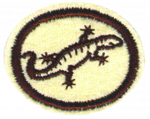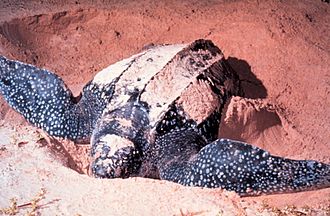AY Honors/Reptiles/Answer Key/es
| Reptiles | ||
|---|---|---|
| Asociación General
|
Destreza: 1 Año de introducción: 1937 |
|
Requisitos
|
La especialidad de Reptiles es un componente de la Maestría Zoología. |
| Conexión Logros para la Investidura: Esta especialidad está relacionada con los requisitos de Logros para la Investidura para AMIGO Estudio de la naturaleza que requiere (como una de dos opciones) el mantener un reptil como está escrito en el requisito 6b de esta especialidad. Esta especialidad es una elección popular para la especialidad de la categoría de Estudio de la naturaleza de nivel de destreza 1 requerido para los AMIGOS. |
1
Los reptiles son animales de sangre fría. Son de piel gruesa. La mayoría tienen escamas y se reproducen por desove, pero varios dan a luz a crías vivas. La falta de una etapa larval distingue los reptiles de los anfibios.
2
Los reptiles también incluyen los cocodrilos y los lagarts, entonces si se pueden encontrar esos animales en su área, deben ser nombrados.
eNature.com is a good resource for this. You can search local wildlife by zip code, and it also gives information about each animal.
You may also wish to review the Wikibooks Field Guide to Reptiles, though as of this writing, it is still very much in its infancy.
3
Some geographic areas have no venomous reptiles, so we choose to interpret "geographic area" as representing an entire continent.
North America
| Reptile | Distribution | Location of Fangs |
|---|---|---|
| Gila Monster | Southwest US, Northern Mexico | Lower jaw |
| Mexican Beaded Lizard | Guatemala, Mexico | Lower jaw |
| Copperhead | Massachusetts south to Florida west to Texas north to Iowa |
Upper jaw, front of mouth |
| Cottonmouth | Eastern US from Virginia, south through the Florida peninsula and west to Arkansas, southeastern Kansas, eastern and southern Oklahoma, and eastern and central Texas. | Upper jaw, front of mouth |
| Coral Snake | Southern and eastern United States | Upper jaw, front of mouth |
| Rattlesnake | Several species, some ranging from southern Canada, others to South America | Upper jaw |
South America
Asia
Europe
Africa
| Reptile | Distribution | Location of Fangs |
|---|---|---|
| Puff Adder | From Morocco and western Arabia throughout Africa except for the Sahara and rain forest regions. | Upper and lower jaws |
| Rinkhals | Southern Africa | Front fangs |
| Terrestrial Tortoise | Land/terrestrial dwellers-SA | Teeth |
| Black Mamba | Wide and occasionally fragmented range of sub-Saharan Africa | Front fangs |
| Cape Cobra | Across southern Africa | Front fangs |
Australasia
4
5
Treatment of a non-venomous snakebite is essentially the same as the treatment for other types of puncture wounds. Clean the wound, cover it with a sterile bandage, and seek medical attention.
6
6a
Life History of the Leopard Gecko
Leopard Geckos become sexually mature at around 10-14 months of age. The Leopard Gecko's gender can be determined once the animal reaches an adult length of 5+".
Leopard Geckos breed from March through September, although the season may begin as early as January and finish as late as October. Thirty days later, the female will lay one or two eggs with a leathery shell. Clutches of two eggs will then be laid every two weeks to monthly throughout the rest of the mating season varying from each gecko according to age, with older females gradually laying fewer eggs with each year. The eggs will need to be incubated.
Like many other egg-laying reptiles the sex of Leopard geckos are determined by incubation temperature. Eggs incubated at 79 F will result in a majority of female neonates, where as eggs incubated at 85 - 87 F will result in a more even sex ratio and eggs incubated at 89 - 90 F in the first four weeks will result in more males. Females hatched from these eggs are generally more aggressive than other females, and they tend to reach sexual maturity later if at all. An incubation temperature lower than 77 F or higher than 97 F will cause deformities and usually death of the neonates incubated at these temperatures.
The eggs hatch 6-12 weeks after being laid depending on temperature. The gecko breaks the surface of the egg and pushes its head out, remaining in this position from 2 to 4 hours adapting to lung breathing and obtaining oxygen from the egg membranes as well as absorbing yolk from inside the egg.
Jewelled Green Gecko (Native of New Zealand)
Along with the New Caledonian rough-snouted gecko (Rhacodactylus trachyrhynchus) all New Zealand Gecko give birth to live young. The eggs hatch in the oviduct and a birth occurs. Each litter consists of two young. After three years, or depending on temperature and food availability causing them to grow to a good size, they become sexually mature. Mating occurs in September-October, and birthing in May-June.
Life History of the Garter Snake
Before they mate, garter snakes go into brumation, which is a state similar to hibernation. They stop eating for about two weeks beforehand to clear their stomach of any food that would rot there otherwise. Garter snakes begin mating as soon as they emerge from brumation. In chillier parts of their range, male common garter snakes awaken from brumation first, giving themselves enough time to prepare to mate with females when they finally appear. After mating, a female leaves the den/mating area to find food and a place to give birth. Female garter snakes are able to store the male's sperm for years before fertilization. The young are incubated in the lower abdomen, at about the midpoint of the length of the mother's body. Garter snakes are viviparous, meaning they give birth to live young. Gestation is two to three months in most species. As few as 3 or as many as 50 snakes are born in a single litter. The babies are independent upon birth.
Life History of the Leatherback Turtle
Like all sea turtles, leatherback turtles start their lives as hatchlings bursting out from the sands of their nesting beaches. Right after they hatch, the baby turtles are already in danger of predation. Many are eaten by birds, crustaceans or other reptiles before they reach the water. Once they reach the ocean they are generally not seen again until maturity. Very few turtles survive this mysterious period to become adults. It is known that juvenile leatherbacks spend a majority of their particular life stage in more tropical waters than the adults.
Adults are prone to long-distance bouts of migration. Migration in leatherback turtles occurs between the cold waters in which mature leatherbacks cruise in to feed on the abundant masses of jellyfish that occur in those waters, to the tropical and subtropical beaches in the regions where they were hatched from. In the Atlantic, individual females tagged in French Guiana off the coast of South America have been recaptured on the other side of the ocean in Morocco and Spain.
Mating between leatherback turtles take place at sea. Leatherback males never leave the water once they enter it unlike females which crawl onto land to nest.
While the other species of sea turtles almost-always return to the same beaches they hatched from, female leatherback turtles have been found to be capable of switching to another beach within the same general region of their "home" beach. Chosen nesting beaches are comprised of soft sand since their shells and plastrons (the turtle's underside) are softer and easily damaged by hard rocks. Nesting beaches also have shallower approach angles from the sea. This is a source of vulnerability for the turtles because such beaches are easily eroded. Females excavate a nest above the high-tide line with their flippers. One female may lay as many as nine clutches in one breeding season. About nine days pass between nesting events. The average clutch size of this particular species is around 110 eggs per nest, 85% of which are viable. The female carefully back-fills the nest after, disguising it from predators with a scattering of sand.
The eggs hatch in about sixty to seventy days. As with other reptiles, the ambient temperature of the nest determines the sex of the hatchlings. After nightfall, the hatchlings dig their way to the surface and make their way to the sea.
Comparisons
| Reptile | Eyes | Ears | Teeth | Heart | Lungs | Limbs | Tails | Scales |
|---|---|---|---|---|---|---|---|---|
| Lizards | movable eyelids |
external | sharp, tricuspid (3-points) |
3 chambers | 2 full lungs |
4 legs | breaks off |
do not grow, but sheds |
| Snakes | transparent eyelids, permanently closed |
internal | grooved or hollow |
3 chambers | left lung smaller or absent |
none | does not detach |
do not grow, but sheds |
| Turtles | have eyelids | external | no teeth, have beaks |
3 chambers | 2 full lungs |
4 legs | tucks into shell |
grow some form shell |
| Crocodiles | one transparent, one opaque |
have "earlids" | sharp, designed to tear |
4 chambers | 2 full lungs |
4 legs | powerful | grow |
6b
Most pet shops carry turtles, lizards, and snakes, as well as the equipment needed to care for them (including terrariums). Pet store staff are generally very knowledgeable about caring for reptiles and will be able to answer your questions. They may also have brochures on reptile care.
Remember that pet reptiles (and amphibians, birds, and small mammals) should never be released into the wild. The main reason for this is that they may not be indigenous to the area and may cause severe ecological problems to the native populations. Further, they can easily spread disease to the native creatures. Even if none of these things come to pass, domestic pets are ill-equipped to survive in the wild, having not lived there in their past.
Therefore, in deciding whether or not to keep a pet reptile to meet this requirement, take this into consideration. If you misjudge your commitment to your reptile pet, you are responsible to find it another home. Under no circumstances should you release a pet into the wild.
7
Eve tempted by the serpent in the garden of Eden (Genesis 3)
Moses and Aaron's staffs becoming snakes (Exodus 4 & 7)
People who were bit by snakes could look at bronze snake on pole to live (Numbers 21)
Paul was bitten by a viper, which he shook off into the fire. The people thought he was a god since he didn't die. (Acts 28)
Referencias
- Categoría: Tiene imagen de insignia
- Adventist Youth Honors Answer Book/Honors/es
- Adventist Youth Honors Answer Book/es
- Adventist Youth Honors Answer Book/Skill Level 1/es
- Categoría: Libro de respuestas de especialidades JA/Especialidades introducidas en 1937
- Adventist Youth Honors Answer Book/General Conference/es
- Adventist Youth Honors Answer Book/Nature/es
- Adventist Youth Honors Answer Book/Nature/Primary/es
- Adventist Youth Honors Answer Book/Stage 100/es
- Adventist Youth Honors Answer Book/Zoology Master Award/Domestic/es
- Adventist Youth Honors Answer Book/IAConnection/es





